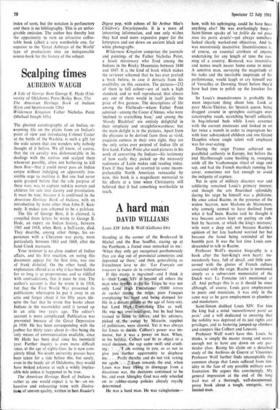Scalping times
AUBERON WAUGH
A Life of George Bent George E. Hyde (Uni- versity of Oklahoma Press/Bailey Bros. 57s) The American Heritage Book of Indians (Eyre and Spottiswoode 126s)
Wilderness Kingdom Father Nicholas Point (Michael Joseph 105s) The ghosted autobiography of an Indian, re- counting life on the plains from an Indian's point of view and introducing Colonel Custer at the battle of the Washita, is such a gift for the wide screen that one wonders why nobody thought of it before. We all know, of course, that the us cavalry was dishonourable in its dealings with the natives and scalped them whenever possible, often not bothering to kill them first—that it could never pass an Indian corpse without indulging an apparently irre- sistible urge to mutilate it. But one had never quite grasped before that the sole purpose of these wars was to capture redskin women and children for sale into slavery and prostitution. It must be true, because it is confirmed in the American Heritage Book of Indians, with an introduction by none other than John F. Ken- nedy. It makes you ashamed to be a paleface.
The life of George Bent, it is claimed, is compiled from letters he wrote to George E. Hyde, an expert on Indian history, between 1905 and 1918, when Bent, a half-caste, died. They describe, among other things, his ex- periences with a Cheyenne war party, most particularly between 1863 and 1868, after the Sand Creek massacre.
Your reviewer is no close student of Indian affairs, and his first reaction, on seeing this document appear for the first time, was one of frank disbelief. On the other hand, the explanation offered as to why it has been hidden for so long is so preposterous, and so riddled with contradictions, that it must be true. The author's account is that he wrote it in 1918, but that the First World War prevented its publication; whereupon he put it away in an attic and forgot about it for fifty years (de- spite the fact that he wrote five books about Indians in the meanwhile) until it turned up in an attic two years ago. The editor's account is more complicated. Publication was prevented because of the Great Depression
ti 1930. He has been corresponding with the author for thirty years about it—this being the only means of communication- available, since. Mr Hyde has been deaf since his twentieth year. Further inquiry is even more difficult since, at the age of eighty-four, he is now com- pletely blind. No doubt university presses have been taken for a ride before this, but surely, even in the heady air of Oklahoma, they would have looked askance at such a wildly implau- sibleitile unless it happened to be true.
The American Heritage Book of Indians is rather as one would expect it to be—an ex- haustive and exhausting tome with illustra- tion of uneven quality, written in best Reader's
Digest pop, with echoes of Sir Arthur Mee's Children's Encyclopaedia. It is a mass of interesting information, and one only wishes they had used more expensive paper for the letterpress and cut down on ancient black and white photographs.
Wilderness Kingdom comprises the journals and paintings of the Father Nicholas Point, a Jesuit missionary who lived among the Indians in the Rocky Mountains between 1840 and 1847. It is the kind of book which makes the reviewer ashamed that he has ever praised a book before, in case it detracts from his credibility on this occasion. The pictures-232 of them in full colour—are of such a high standard, and so well reproduced, that almost any one of them would in itself justify the price of five guineas. The descriptions of life among the Flatheads—whom Father Point admired—among the Coeur d'Alenes, who were `inclined to everything base,' and among the `bloody Blackfeet' are entirely delightful in their simplicity and straightforwardness; but the main delight is in the pictures. Apart from the pleasure to be derived from them as vivid, exquisite cameos in their own right, they are the only series ever painted of Indian life at first hand. Father Point also used pictures in his work of converting the Indians—his testimony of how easily they picked up the necessary rudiments of Latin makes odd reading today. Even if they have all reverted to some incom- prehensible North American vernacular by now, this book is a magnificent memorial to his efforts at a time when Christianity still believed that it had something worthwhile to teach.






































 Previous page
Previous page